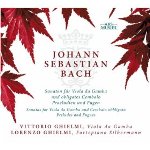This is a very fine recording, smartly programmed and beautifully played, engineered to optimize timbres and balances while placing us close–but not too close–to the instruments. It’s not exactly a new production–it was recorded in 1997–and I found myself confused by a new release from this same label whose cover looks almost identical and whose program also contains the gamba sonatas, but with different performers, playing on bass gamba and harpsichord.
The notes make much of Bach’s encounters with the fortepiano, and suggest the possibility that Bach may have owned one of these instruments–from there proposing that the fortepiano could be considered an “authentic” instrument on which to play Bach’s keyboard works, especially the later ones. Whatever the historical argument for or against, when you hear these particular two period instruments–Vittorio Ghielmi’s 1688 gamba and Lorenzo Ghielmi’s meticulously-created copy of a 1749 Silbermann fortepiano–you hear the sound of a perfect instrumental marriage, marveling at how complementary they are. I’ve never been a fan of the fortepiano, but this one–full-bodied, rich bass, and even a robust upper register (no clanging or thunking!)–convinced me that there’s at least one fortepiano I can happily listen to for an hour–and more.
These performers also are easy to listen to. Gamba player Vittorio (brother of Lorenzo) draws a big sound from his mahogany-bodied instrument, and perhaps some listeners will find him too assertive here and there in the faster movements. But to me his strong voice makes an ideal partner to the distinct bass and treble voices played by the fortepiano, whose appeal is enhanced by its several stops, which Lorenzo employs to delightful effect. In the slow movements, “singing” is a particularly apt description of Vittorio’s expressive technique, especially notable in the Adagio of BWV 1029.
Between the sonatas, Lorenzo offers three sets of preludes and fugues from The Well-tempered Clavier, Book II. It didn’t hurt to discover that he was performing three of my favorites–nor to learn that he doesn’t fuss over these like some annoyingly indulgent performers do. Instead, he plays them with a straightforward, confident, spirited style, and with impressive clarity. Again, this fortepiano seems an ideal instrument for this music, and I wonder where it is today–is it being used on other recordings? Nevertheless, this is one of the better recordings of the gamba sonatas–and if you’re not on happy terms with fortepianos, I urge you to try this; I think you’ll like it. [6/22/2010]
































